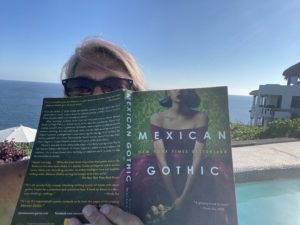
Vacation Reading
Howdy Scramblers, hope you’ve all been dandy. I vacationed for an entire month and besides enjoying 30 days in Oaxaca and Puerto Escondido, I read plenty. I was lucky, all the books I packed were worthy of being hauled down to 15 degrees latitude. These are the three:
Sally Rooney’s most recent, Beautiful World, Where are You is more of Rooney’s elegant writing about intimate relationships (or as in most of this novel, the lack of such relationships). Rooney’s writings, I feel, have a certain Austen vibe. This book is filled with keen commentary on 21st century mores but Rooney’s writing is strongest when she focuses on the hearts of her characters. In Beautiful World, Where are You Rooney writes about a famous young author named Alice, a man named Felix that Alice meets on Tinder, Alice’s best friend Eileen, and Eileen’s longtime friend and longtime secret crush, Simon. The relationships between the four, which start, wobble, and begin again, are the center of the story. Relationship building should be easy when the characters are young, beautiful, and smart…but no. And so, the tale unfurls.
Rooney takes her time telling the story, sidetracking us by whispering in our ear about the drippy Irish coast, the bustle of an author’s tour, the marriage of a bratty sister and then shifts gears with ease revealing deeper insights in the letters Alice and Eileen write each other.
Rooney also gives us obvious glimpses of herself in this book. Reviewers assume that the successful author, Alice, is Rooney’s doppelganger. I’ll buy that. It’s hard to imagine what Rooney’s wild success must feel like at age 30, but what she shows us through Alice is that while young writerly triumph can at least buy a stately home in a beautiful place, the pathway leading to and from the sanctuary is rocky.
Mexican Gothic by Silvia Moreno-Garcia was a vacation-specific selection. What I didn’t expect was that our lodging in Oaxaca, La Calera, was an industrial remain of an old lime slake factory and next door was an extensive graveyard. Dear readers, the place was thick with ghosts and bumps in the night. And in less than 24 hours after settling in at La Calera, we were joined by a black cat who insisted (thankfully) on sleeping on my bed each night. And more, we were disturbed by a motion light in the bathroom that turned on and off randomly throughout the dark hours, making a notable clicking noise when doing so. (When we explained the motion light problem to Ignacio, the property manager, he said patiently, “well, it’s a motion light” and then he pointed at the graveyard!)

Noémi is the heroine in Mexican Gothic. In 1950 Mexico City, Noémi is considered a modern woman. She lives at home with her rich family, spends her expansive free time moving through cocktail parties, juggling beaux, and shopping. In spite of all this brightness the story begins with a tangible waft of menace. Noémi’s cousin, Catalina, writes a frenzied letter to the family begging for help. Catalina claims her husband is poisoning her and that headless monsters living in the wall terrorize her every night. Hoping to settle down his flighty daughter by giving her problem to solve, Noémi’s father sends Noémi to determine if Catalina truly needs help.
As the train carries Noémi high into a cloudy forest in the mountains, the story ratchets up the ‘whiff of menace’ to full-on creepiness. Catalina lives outside a silver mining town with her husband’s sinister family and enfolded in a deteriorating mansion that lacks electricity but boasts an abundance of mildewy wallpaper. Catalina’s in-laws are straight out of the Third Reich and in even in early days of the visit, Noémi knows Catalina is right to fear for her life. But Noémi can’t easily bundle up the ailing Catalina and walk her out of the house. There are strict house rules about women not being allowed to drive and there is little chance for discussion of this rule because another rule demands silence at the dinner table.
It doesn’t take long before vibrant Noémi begins to lose it too as her dreams morph into haunted nightmares; from another world, it seems, a woman whose face is a golden cloud tries to tell Noémi secrets. And Catalina’s husband appears in the nightmares too, lusty and violent. Noémi figures she is losing her mind like Catalina but during her lucid moments she understands the visit now more closely resembles a forced confinement.

Oh boy, from the haunted dreams onward, this book was so scary I could only read the final chapters in the bright Mexican sun.
Mexican Gothic also runs a strong subtext about colonialism, ecological exploitation, and racism. But it’s the surface components, the haunted house, heroines, monsters, darkness, fog, cemeteries, and flowing nightgowns that will stick with you once you turn off the light.
This book is big scary fun!
Oaxaca Journal by Oliver Sacks was a given to me by my travelling partner, Heather. I read this book in Puerto Escondido after spending 3 glorious weeks in Oaxaca.
This charming book is a journal Sacks kept during a trip he made to Oaxaca with a fern appreciation society. Isn’t that just delightful? It makes me smile simply typing the words. Sacks joined the group when he passed the Fern Appreciation meeting room multiple times in New York and spied some interesting looking people. Plus, it turns out that Sacks preferred ferns over flowers because he thought flowers’ showiness were “a bit too much”.
If you’ve read any of Sacks’ books you know the material in the book will not be about ferns alone, it will include intriguing sidebars about a variety of subjects that captured his interest. And in Oaxaca, Sacks struck gold, there was so much to take in.
Here are some fun facts about tobacco that Sacks shares in his fern book:
- The Mayan word for smoking tobacco was sik’ ar.
- When Rodrigo de Jerez brought tobacco back to Spain, his neighbors saw smoke coming from Rodrigo’s mouth and nose and brought in Inquisitioners. Rodrigo served seven years.
- Sir Walter Raleigh brought tobacco back to England and when he smoked in front of his servant, the servant threw a bucket of water on him, assuming Raleigh was on fire.
Sacks takeaway from the Oaxaca trip were similar to mine after I walked through a thriving village in 2021 that the Conquistadors sacked and burned in the 1500’s and then enslaved the inhabitants and destroyed their cultural artifacts. The takeaway was this: Conquistadors came for the gold and silver but the real wealth – the botanical richness, the tobacco, tomatoes, potatoes, chocolate, gourds, chilies, peppers, latex, rubber, chewing gum, design skills, the science, the creativity, and the mighty hallucinogens – well, the Conquistadors were just too stupid and greedy to see the real wealth.
Did not Finish Pile: A good book by a great author, Once there were Wolves by Charlotte McConaghy. There is something inside me lately that makes it impossible to read books where animals die at the hand of cruel humans. I would love for someone to read it and tell me the story. But for now, it is too rough to read on my own. I’m off to tackle my YA pile. Peace out friends.




